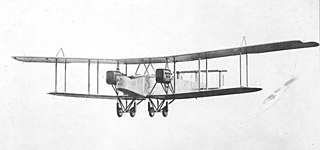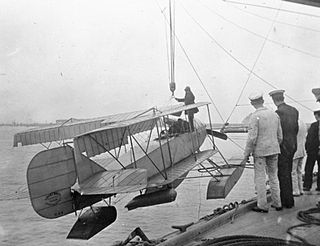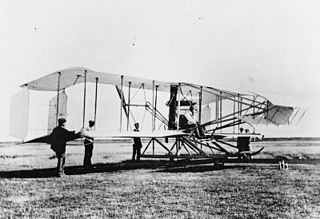
The Handley Page Type O was a biplane bomber used by Britain during the First World War. When built, the Type O was the largest aircraft that had been built in the UK and one of the largest in the world. There were two main variants, the Handley Page O/100 (H.P.11) and the Handley Page O/400 (H.P.12).

The Boxkite was the first aircraft produced by the British and Colonial Aeroplane Company. A pusher biplane based on the successful Farman III, it was one of the first aircraft types to be built in quantity. As the type was used by Bristol for instruction purposes at their flying schools at Larkhill and Brooklands many early British aviators learned to fly in a Boxkite. Four were purchased in 1911 by the War Office and examples were sold to Russia and Australia. It continued to be used for training purposes until after the outbreak of the First World War.

The Short S.14 Sarafand was a British biplane flying boat built by Short Brothers. It was planned as a general reconnaissance aircraft for military service. When it was built in 1932 it was the largest aeroplane in the United Kingdom.

The Short Bomber was a British two-seat long-range reconnaissance, bombing and torpedo-carrying aircraft designed by Short Brothers as a land-based development of the very successful Short Type 184.
The Short Admiralty Type 74 was a single-engined biplane tractor seaplane with non-folding wings, which saw service with the Royal Naval Air Service during the First World War.

The Norman Thompson N.T.4 was a twin-engined British flying boat of the First World War. Although less well known than similar Curtiss and Felixstowe flying boats, 50 were ordered for Britain's Royal Naval Air Service.

The Dunne D.5 was an experimental aircraft built in the United Kingdom in 1910. Designed by J. W. Dunne and built by Short Brothers at Leysdown, A tailless swept-wing biplane, the D.5 was the first aircraft built by his company, the Blair Atholl Aeroplane Syndicate Ltd. Like its military predecessors it was driven by twin pusher propellers, but it had a considerably more powerful engine.

The White and Thompson No. 3 was a British flying boat of the First World War. While the prototype was originally designed to compete in an air-race around the UK, eight more similar aircraft were built for the Royal Naval Air Service.
The Short No.2 was an early British aircraft built by Short Brothers for J.T.C. Moore-Brabazon. It was used by him to win the £1,000 prize offered by the Daily Mail newspaper for the first closed-circuit flight of over a mile (1.6 km) to be made in a British aircraft.
The Short S.45 — also known as the Short T.5 after its naval serial number — was a training biplane built for Britain's Royal Navy by Short Brothers in 1912. It was the forerunner of another three identical aircraft delivered to the Royal Navy and Royal Flying Corps during 1912 and 1913. The Royal Naval Air Service was still operating the type when World War I broke out in 1914.

The Albatros C.II was a 1910s German military pusher reconnaissance biplane designed and built by Albatros Flugzeugwerke. Only one aircraft was built and the type did not enter production.

The Short S.27 and its derivative, the Short Improved S.27, were a series of early British aircraft built by Short Brothers. They were used by the Admiralty and Naval Wing of the Royal Flying Corps for training the Royal Navy's first pilots as well as for early naval aviation experiments. An Improved S.27 was used by C.R. Samson to make the first successful take-off from a moving ship on 9 May 1912.

The Short Admiralty Type 81 was a series of British two-seat floatplanes built prior to the First World War, and used by the Royal Naval Air Service in the early years of the war. They were powered by 160 hp (120 kW) Gnome Lambda-Lambda 14 cylinder two-row rotary engines and had folding wings to aid storage on ship, hence the popular name Short Folder, shared with a number of other seaplanes made by Short Brothers.
The Burgess Type O Gunbus was an American pusher biplane fighter designed and built by the Burgess Company at Marblehead, Massachusetts.

The Short S.81 was an experimental British gun-carrying pusher biplane seaplane, ordered from Short Brothers by the British Admiralty in 1913 for use by the Royal Naval Air Service.

The Supermarine Type 525 was a British prototype naval jet fighter aircraft of the 1950s.

The Short No.1 biplane was an early British aircraft built in 1909 by Short Brothers. Although it never flew, it was notable for being the first aircraft designed by Horace Short.
The Short S.80 was an early British floatplane built by Short Brothers for Frank McClean to undertake an aerial expedition up the Nile to investigate the cataracts between Aswan and Khartoum. After a successful flight to Khartoum it was returned to England, where it was used for training by the RNAS. When built it was the largest successful aircraft that had been constructed in Britain. It was also known as the Short Nile Pusher Biplane Seaplane.
The Short S.47 Triple Tractor was one of a series of experimental twin-engined aircraft built by Short Brothers in 1912. It acquired its name because the two engines drove three tractor propellers.
The Sopwith Sociable was a British single-engined two-seat tractor configuration biplane designed and built by Sopwith for the Royal Naval Air Service.













